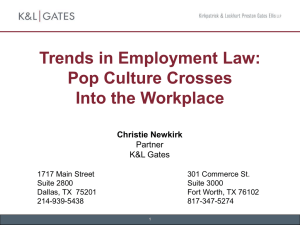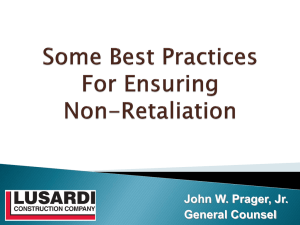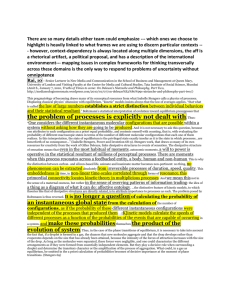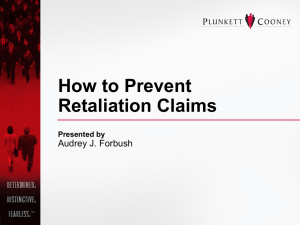2006 CLE: Retaliation Claims After Burlington Santa Fe v. White
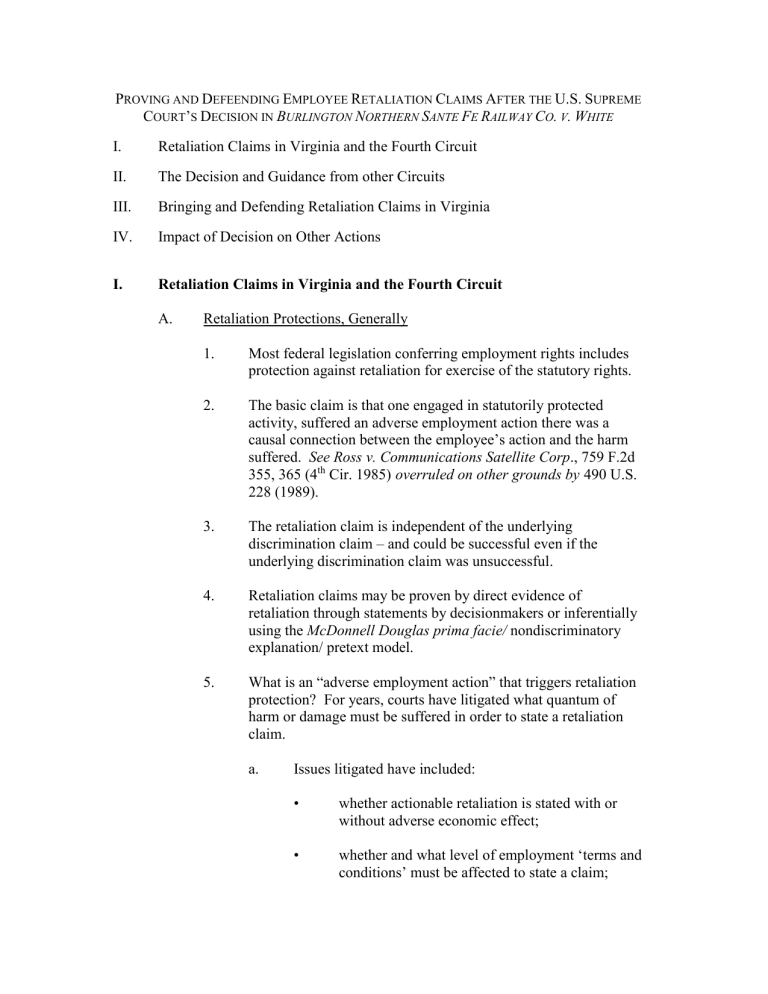
P
ROVING AND
D
EFEENDING
E
MPLOYEE
R
ETALIATION
C
LAIMS
A
FTER THE
U.S.
S
UPREME
C OURT ’ S D ECISION IN B URLINGTON N ORTHERN S ANTE F E R AILWAY C O .
V .
W HITE
I. Retaliation Claims in Virginia and the Fourth Circuit
II. The Decision and Guidance from other Circuits
III. Bringing and Defending Retaliation Claims in Virginia
IV. Impact of Decision on Other Actions
I. Retaliation Claims in Virginia and the Fourth Circuit
A. Retaliation Protections, Generally
1. Most federal legislation conferring employment rights includes protection against retaliation for exercise of the statutory rights.
2. The basic claim is that one engaged in statutorily protected activity, suffered an adverse employment action there was a causal connection between the employee’s action and the harm suffered. See Ross v. Communications Satellite Corp ., 759 F.2d
355, 365 (4 th
Cir. 1985) overruled on other grounds by 490 U.S.
228 (1989).
3. The retaliation claim is independent of the underlying discrimination claim – and could be successful even if the underlying discrimination claim was unsuccessful.
4. Retaliation claims may be proven by direct evidence of retaliation through statements by decisionmakers or inferentially using the McDonnell Douglas prima facie/ nondiscriminatory explanation/ pretext model.
5. What is an “adverse employment action” that triggers retaliation protection? For years, courts have litigated what quantum of harm or damage must be suffered in order to state a retaliation claim. a.
•
Issues litigated have included:
• whether actionable retaliation is stated with or without adverse economic effect; whether and what level of employment ‘terms and conditions’ must be affected to state a claim;
1.
• what quantum of evidence is required; and
• do the protections extend to former employees.
B. Retaliation Claims Under Title VII of the Civil Rights Act of 1964
42 U.S.C. § 2000e et seq.
(Title VII) prohibits discrimination against employees or applicants in compensation, terms, conditions or privileges of employment on the basis of race, color, religion, sex, or national origin. a. This statute forbids both intentional discrimination which treats an individual less favorably because he/she is in a protected class (disparate treatment discrimination) and facially neutral practices which have a disparate impact on members of a protected class (disparate impact discrimination).
2. Title VII’s retaliation protection is found in Section 704(a) [42
U.S.C. § 2000e-3 (a)]:
It shall be an unlawful employment practice for an employer to discriminate against any of his employees or applicants for employment, for an employment agency, or joint labor-management committee controlling apprenticeship or other training or retraining, including on the job training programs, to discriminate against any individual, or for a labor organization to discriminate against any member thereof or applicant for membership, because he has opposed any practice made an unlawful employment practice by the title, or because he has made a charge, testified, assisted, or participated in any manner in an investigation, proceeding, or hearing under this title.
(emphasis added)
3. The protection against retaliation resides in two clauses: the
“opposition” clause and the “participation” clause a. “Opposition” to unlawful conduct includes both formal challenges to conduct and informal challenges of suspected violations. b. In Armstrong v. Index Journal Co., 647 F.2d 441
(4 th Cir. 1981) a female sales rep for a newspaper advertising department who was discharged after making internal complaints of gender based pay
c. and job classification disparities and was discharged stated actionable retaliation.
Bryant v. Aiken Reg. Med. Ctrs., Inc.
, 333 F3d.
536 (4 th
Cir. 2003) (internal complaint of race discrimination supports claim for retaliation in failure to promote); see also
Knox v. Scope
Hospitality Corp., 59 FEP 455 (E.D. Va. 1992)
(letter to defendant threatening to file EEOC charge was protected activity supporting retaliation claim); EEOC v. Virginia Carolina
Veneer Corp., 495 F. Supp. 775 (W.D. Va. 1980), appeal dismissed , 652 F.2d 380 (4 th Cir. 1981)
(suit by defendant alleging EEOC charge contained defamatory allegations that plaintiff was discriminated against based on her sex was admission of retaliatory motive by employer and summary judgment on retaliation granted to plaintiff). i. The Fourth Circuit has used a test of a reasonable, good faith belief that the alleged employer practices occurred and would be violative of Title VII to trigger the anti-retaliation protection. EEOC v.
Navy Fed. Credit Union , 424 F.3d 397,
406-07 (4 th Cir. 2005); Nealon v. Stone ,
958 F.2d 584,, 590 (4 v. Jenney th Cir. 1992); Peters
, 327 F.3d 307 (4 th Cir. 2003)
(Title VI retaliation case applying Title
VII principles: the inquiry is whether the plaintiff subjectively believed (i.e. in good faith) that the defendant engaged in a practice that violated civil rights law and whether the belief was objectively reasonable under the facts); Dempsey v.
Harrison, 387 F.Supp. 2d 558 (E.D.N.C.
2005) (applied to an “opposition” clause case). ii. Unlawful actions are not protected. Where an employee’s actions are unreasonable and not proportional to the need under the circumstances, opposition protection may be lost. See
Laughlin v. Metro.
Washington Airports Auth.
, 149 F.3d 253,
b.
259 (4 th
Cir. 1998)
(employee’s surreptitious copying and forwarding draft internal document to co-worker so that the co-worker could assert a Title VII claim held not to be protected opposition. The
Court also held that without a pending
“investigation, proceeding or hearing” at the time of the action, there was no
“participation” protection for participation in an ongoing investigation.) iii. In Clark County School District v.
Breeden , 532 U.S. 268, 270 (2001), the
U.S. Supreme Court expressly declined to rule on whether a “reasonable belief” test was the appropriate standard.
“Participation” in a Title VII investigation, proceeding or hearing extends to filing a charge of discrimination and testimony in administrative or court proceedings. i. Thus, participation protection extends to those who assist others in claims, and to witnesses. ii.
In Glover v. South Carolina Law
Enforcement Div., 170 F.3d 411 (4 th Cir.
1999) cert. dismissed , 528 U.S. 1146
(2000) the 4 th Circuit held that a deposition witness was protected in testimony that was devoted to hours of unsolicited attacks on certain management employees irrelevant to the employee’s suit. The Court rejected the employer’s assertion that the “unreasonableness” of the testimony took it outside the protection of the provision – no reasonableness standard attaches to the participation clause, which allows for participation “in any manner.” iii. In Curl v. Reavis , 740 F.2d 1323 (4 th Cir.
1984), retaliation was stated where a discharged female deputy sheriff was told that she would not be promoted to
dispatcher unless she dropped a pending
EEOC charge.
C.
History of Protected Conduct in the Fourth Circuit
1.
2.
Decisions involving “ultimate employment actions” include hiring, firing, promotions, compensation and granting leave, and have been held actionable under Title
VII retaliation clauses. See Page v. Bolger , 645 F.2d 227,
233 (4 th Cir. 1981) (en banc). a. The Fourth Circuit coined the phrase “ultimate employment actions in Page v. Bolger , a case involving the Title VII provision protecting federal employees from disparate treatment. Page was cited by other courts as a basis for requiring a higher showing of harm, an “ultimate employment action,” before a Title VII retaliation claim was actionable. See Mattern v. Eastman Kodak Co.,
104 F.3d 702 (5 th Cir. 1997);
Crawford Bldg. Material Co.,
Hernandez v.
321 F.3d 528 (5 th
Cir. 2003), cert. denied 540 U.S. 817 (2003);
Manning v. Metropolitan Life Ins. Co., 127 F.3d
686 (8 th Cir. 1997). b. The Fourth Circuit did not adhere to the “ultimate employment action” standard. Rather, it held that actionable retaliation required a showing that an
“act or harassment [that] results in an adverse effect on the ‘terms, conditions or benefits’ of employment’” which may be something less than an ultimate employment decision. Von Gunten v.
Maryland , 243 F.3d 858, 866 (4 th Cir. 2001)
(expressly rejecting Page v. Bolger as limited to federal “personnel actions” which apply different statutory language); see also Munday v. Waste
Mgmt. of N. America , 126 F.3d 239 (4 th Cir. 1997)
(harassment not actionable because it did not affect the “terms, conditions or benefits” of the plaintiff’s employment).
The parameters of the Fourth Circuit’s analysis of
“adverse employment action” for actionable retaliation has focused on Title VII’s substantive “terms, conditions or benefits of employment” language.
a.
Failure to promote. As with other “ultimate employment actions,” a failure to promote an employee constitutes an adverse employment action for the purposes of § 2000e-3 retaliation.
Bryant v. Aiken Reg. Med. Ctrs., Inc., 333 F3d.
536 (4 th Cir. 2003); Von Gunten v. Maryland, 243
F.3d 858, 865 (4 th
Cir. 2001); Page v. Bolger, 645
F.2d 227, 233 (4 th
Cir. 1981). b.
Constructive Discharge.
Constructive discharge may be an adverse employment action in violation of § 20003e-3(a) "when the record discloses that it was in retaliation for the employee's exercise of rights protected by the Act." Holsey v. Armour &
Co.
, 743 F.2d 199, 209 (4th Cir. 1984), cert. denied , ; however, a voluntary resignation is not actionable retaliation. See Shealy v. Winston, 929
F.2d 1009, 1012-13 (4th Cir. 1991); Evans v.
Davie Truckers, Inc., 769 F.2d 1012, 1014 (4th
Cir. 1985) (because the "evidence clearly established that [the employee] voluntarily resigned his employment with the defendant, [he] suffered no adverse employment action at the hand of the defendant" (internal quotation marks omitted)).
c.
Selective Treatment. Protection did not extend to an employer instruction to ignore and spy on an employee who engaged in protected activity, without evidence of adverse affect on terms, conditions or benefits of employment. Munday v.
Waste Mgmt. of N. America , 126 F.3d 239 (4 th
Cir. 1997); See also Hopkins v. Baltimore Gas and Elec. Co ., 77 F.3d 745, 754 (4th Cir. 1996)
(employee was not discharged from employment, and the challenged comments that he ‘should put
(conduct of a co-worker he had complained about) behind him’, a disciplinary warning later removed, requirement to undergo a ‘fitness for duty’ psychological exam and comments, without a reduction in ratings on his evaluation that he needed improvement in ‘job behavior’ and
‘employee relations ’ did not result in any adverse employment action).
d. Reprimand and Reassignment. In DiMeglio v.
Haines , 45 F.3d 790, 804, n.6 (4 th
Cir. 1995) the
Court held that a reprimand and reassignment may constitute an actionable adverse employment action for retaliation; but see Boone v. Goldin ,
178 F.3d 253, 256 (4 th Cir. 1999) (reassignment to a job with “some modest stress” is not a cognizable adverse employment action). e. Surveillance. In Warren v. Halstead Indus., 802
F.2d 746 (1986), aff’d on reh’g
, 835 F.2d 535 (4 th
Cir. 1988) (en banc) the Court held that workplace harassment in the form of surveillance was actionable retaliation (black employees sought to discuss selective treatment with plant manager, which was denied, and after which the immediate supervisor began keeping note cards documenting performance. Plaintiff’s termination two weeks later for “wasting company time” and “lack of cooperation,” based on the note cards, was held actionable retaliation).
3.
The Fourth Circuit has clearly viewed Title VII retaliation in the context of what Title VII protects in its substantive discrimination protection - “terms, conditions and benefits” of employment. a.
In Thompson v. Potomac Electric Power Co., 312
F.3d 645, 650-51 (4 th Cir. 2002) the Fourth
Circuit cited Von Gunten v. Maryland , 243 F.3d
858, 866 for the proposition that, “this circuit has held that an adverse employment action includes any retaliatory act ‘if, but only if’ that act adversely affected the ‘terms, conditions, or benefits’ of his employment.” b.
In Boone v. Goldin , 178 F.3d 253, 256 (4 th
Cir.
1999), a case involving a reassignment, the Fourth
Circuit analyzes a combined discrimination and retaliation claim in the context of the Supreme
Court’s
Burlington Industries, Inc. v. Ellerth , 524
U.S. 742 (1998) discussion of a “tangible employment action.” Ellerth was a hostile environment sex discrimination claim addressing
the imputation of liability on an employer for the sexually harassing actions of a supervisor. i.
Addressing the type of conduct which is actionable retaliation, the Fourth Circuit in
Boone reviewed and applied the Supreme
Court’s discussion of when a Title VII employer is strictly liable for the conduct of its supervisors.
ii. In Ellerth he Supreme Court established a
“tangible employment action” standard for the imputation of such strict liability.
Extending this analysis to retaliation, the
Boone Court stated that “Title VII liability can arise from a ‘tangible employment action,’ which the Court defined to include not only ‘hiring, firing, failing to promote,
. . . [and] significant change in benefits," but also "reassignment with significantly different responsibilities.’ Burlington
Industries, Inc. v. Ellerth , 524 U.S. 742,
118 S. Ct. 2257, 2268, 141 L. Ed. 2d 633
(1998)(discussing "tangible employment action" as trigger for employer's strict liability under Title VII for supervisor's discriminatory acts)” c.
Supporting the position that retaliation requires a higher form of adverse action, the Boone opinion also cites to a sexual harassment decision in Reinhold v. Commonwealth of Virginia , 151 F.3d 172, 175 (4 th
Cir. 1998) (“While
Reinhold alleges that she was assigned extra work and suffered other harm as a result of her rejection of Martin's sexual advances, she does not allege that she experienced a change in her employment status akin to a demotion or a reassignment entailing significantly different job responsibilities.”)
3. A Restrictive View of Employment Status. The Fourth
Circuit determined that a former employee does not have standing to sue for retaliation under Title VII. Robinson v. Shell Oil Co ., 70 F.3d 325 (4 th Cir. 1995) (en banc)
D. The Supreme Court’s Robinson v. Shell Oil Co.
Decision
1. In Robinson v. Shell Oil Co.
, 519 U.S. 337 (1997), a unanimous Supreme Court reversed the en banc Fourth
Circuit decision in holding that § 704(a) protected a former employee from retaliation for participation in Title
VII proceedings. a. Robinson claimed that he had been retaliated against by his former employer when he was given a negative evaluation to a prospective employer because he had filed an EEOC charge after he was fired. b. The Court held that Title VII’s use of the term
“employee” was ambiguous, but that the policy underlying Title VII was more consistent with holding protection for former employees and not limiting interpretation and coverage to only
“current” employees. c.
The Court held, “[t]he EEOC quite persuasively maintains that it would be destructive of this purpose of the antiretaliation provision for an employer to be able to retaliate with impunity against an entire class of acts under Title VII--for example, complaints regarding discriminatory termination. We agree with these contentions and find that they support the inclusive interpretation of "employees" in § 704(a) that is already suggested by the broader context of Title VII.”
519 U.S. at 346.
E. Proof of Retaliation
1. Proof of retaliation may be made by direct or indirect proof. a. "[A]n employee may utilize 'ordinary principles of proof using any direct or indirect evidence relevant to and sufficiently probative of the issue.'" Brinkley v. Harbour Recreation Club, 180
F.3d 598, 607 (4 th
Cir. 1999) , (quoting Tuck v.
Henkel Corp., 973 F.2d 371, 374 (4 th
Cir. 1992)). b. To state a claim, "the plaintiff 'must produce direct evidence of a stated purpose to discriminate and/or [indirect] evidence of sufficient probative
2.
3. force to reflect a genuine issue of material fact.'"
Brinkley , 180 F.3d at 607 (quoting Goldberg v. B.
Green & Co., 836 F.2d 845, 848 (4 th Cir. 1988))
(alteration in original). "'What is required is evidence of conduct or statements that both reflect directly the alleged discriminatory attitude and that bear directly on the contested employment decision.'" Brinkley , 180 F.3d at 607 (quoting
Fuller v. Phipps, 67 F.3d 1137, 1142 (4th Cir.
1995)).
When direct or indirect, circumstantial evidence of retaliation are not available, r etaliation claims may be proven inferentially using the 3-phase McDonnell
Douglas model of (1) a prima facie showing of engaging in a protected activity and causally connected adverse action; (2) the employer’s nondiscriminatory explanation; and (3) a showing that the explanation is pretext. Rhoads v. FDIC , 257 F.3d 373 (4 th Cir. 2001), cert. denied, 535
U.S. 933 (2002).
Under the McDonnell Douglas model, proof that employer's explanation for adverse employment actions is false is a form of circumstantial evidence probative of intentional discrimination.
St. Mary's Honor Center v.
Hicks, 509 U.S. 502, 517 (1993); see also Wright v. West,
505 U.S. 277, 296, (1992) (stating that the fact finder is entitled to consider a party's dishonesty as affirmative evidence of guilt). a. b.
See Warren v. Halstead Indus., 802 F.2d 746
(1986), aff’d on reh’g
, 835 F.2d 535 (4 th
Cir.
1988) (en banc), in which the Court held that keeping meticulous records of work activities through note cards after complaints of discrimination was an extraordinarily unusual practice
and that pretext was demonstrated.
In
Karpel v. Inova Health Sys. Servs., 134 F.3d
1222 (4 th Cir. 1998) the plaintiff failed to rebut legitimate, non-discriminatory reasons where the employer documented unsatisfactory job performance and the plaintiff could not show that she was written up differently from any similarly situated employees.
c. In Anderson v. G.D.C., Inc., 281 F.3d 452 (4 th Cir.
2002), summary judgment for the employer was reversed on a retaliation claim where the plaintiff offered evidence that she was treated differently on the day following her complaints of sexual harassment. After consistently being assigned work, on the day after she complained of her boss’ pressing his penis into her buttocks, she was told that no work was available for her. d.
4.
Establishing causation through the timing of actions taken.
In Matvia v. Bald Head Island Mgmt., Inc., 259
F.3d 261 (4 th Cir. 2001), the Fourth Circuit affirmed the grant of summary judgment to an employer on a retaliatory failure to promote claim. Although the decision came shortly after a complaint of sexual harassment, it was based on a ranking of qualifications and no pretext was shown. Additional claims of retaliation, including failure to correct co-worker actions, were denied as not stating adverse actions.
a.
The strength of the ‘temporal proximity’ inference depends on whether the inference derives solely from the timing or if other evidence accompanies the timing of the adverse actions. b.
A short time between the protected action and adverse employment action supports an inference of causal connection. See Williams v.
Cerberonics, Inc., 871 F.2d 452, 457 (4 th Cir.
1989 ) (three months from filing of discrimination charge until suspension and proof that managers knew of the filing by the time of the suspension, although j.n.o.v. affirmed because trial evidence supported position that employer rebutted inference with proof of non-discriminatory reasons for adverse actions .
) c.
Kralowec v. Prince George’s County
, 503 F.Supp.
985 (D. Md. 1980), aff’d without op., 679 883 (4 th
Cir. 1982) (termination procedures initiated within one month after filing discrimination
5. complaint with county attorney supported inference of retaliation) d. e.
Lampley v. Big Discount Food Store, Inc., 687 F.
Supp. 211 (M.D.N.C. 1988) (approximately ten days between filing EEOC charge and discharge)
King v. Rumsfeld , 328 F.3d 145 (4 th
Cir. 2003), cert. denied , 540 U.S. 1073 (2003)
(comprehensive and on-going reviews after filing
EEOC complaint followed by termination twoand-one-half months after filing complaint raised sufficient inference of causation – but employee could not establish pretext under the facts) f. Causey v. Balog , 162 F.3d 795 (4 th Cir. 1998) (13 month interval between charge and discharge too long to establish causation without additional evidence and citing 10 th
Circuit case holding 4 months, without more, as too long) g. Dowe v. Total Action Against Poverty , 145 F.3d
653 (4 th Cir 1998) (3 year gap negates inference of causal connection) h. Tinsley v. First Union Nat’l Bank
, 155 F.3d 435
(4 th
Cir. 1998) (14 year gap too long)
Breaks in Causation – who-done-it, no-harm-no-foul, knowledge of the protected activity, decision-makers and the RIF defense a. who-done-it? In Wilson v. Southern Nat’l Bank ,
900 F. Supp. 803 (W.D.N.C. 1995), aff’d without op ., 92 F.3d 1184 (4 th
Cir. 1996) it was determined that plaintiff’s co-workers, not her employer, took the “adverse” action against her after she complained of their alleged harassment; the employer took prompt corrective action. b. no-harm-no-foul. In Gibson v Old Town Trolley
Tours , 160 F.3d 177 (4 th
Cir. 1998), although it was shown that the supervisor knew of the plaintiff’s EEOC complaint, the Fourth Circuit reversed the district court’s judgment on a jury verdict and found no showing of pretext. The
Fourth Circuit held that the plaintiff offered no evidence that the complaint in any way triggered the company’s failure to supply a reference or that not providing a reference, given the circumstances, was unusual.
c. d.
The RIF defense. In Hopkins v. Baltimore Gas &
Elec. Co., 77 F.3d 745 (4 th Cir. 1996) no adverse action was shown when an entire department was eliminated in a RIF, including the supervisor (and alleged harasser).
In Beall v. Abbott Labs., 130 F.3d 614 (4 th Cir.
1977) the plaintiff failed to show that the elimination of her territory and discharge during
RIF after she complained of sexual harassment was retaliatory. The Court stated that plaintiff offered no proof of selective treatment, whereas the employer showed that the plaintiff had been on leave for over 6 months and that the employer had acted in accordance with the company’s
‘vacant territory’ policy. e. No knowledge. In Dowe v. Total Action Against
Poverty , 145 F.3d 653 (4 th Cir 1998) the Fourth
Circuit affirmed summary judgment when there was no showing that the individual that fired plaintiff was aware that the plaintiff had filed a charge with EEOC.
6.
Mixed motive analysis is not allowed in retaliation claims a.
b.
Some Courts, including the Fourth Circuit, have held that mixed motive analysis is not appropriate in retaliation claims. c.
The Civil Rights Act of 1991, which statutorily imposed mixed motive analysis in Title VII claims, did not specifically include retaliation claims.
Kubicko v. Ogden Logistics , 181 F.3d 544, 552, n.7 (4 th Cir. 1999) (mixed motive clause of CRA of 1991, § 107(a) specifically refers to some types of unlawful employment practices but does not expressly apply to retaliation claims)
5. Where retaliation is "in part" a reason for an adverse employer actions, a plaintiff in the Fourth Circuit still has been required to show that he would not have been discharged "but for" the filing of the charge on the protected activity. Ross v. Communications Satellite
Corp., 759 F.2d 355, 365-66 (4 th
Cir. 1985) .
See also
Lovelace v. Sherwin-Williams Co., 681 F.2d 230, 243-44
(4 th
Cir. 1982) (ADEA) .
An employee who is legitimate disciplined for unsatisfactory performance is not immunized by filing an EEOC charge. EEOC v. Federal
Reserve Bank of Richmond, 698 F.2d 633, 668-89 (4 th
Cir. 1983), rev'd on other grounds sub nom. Cooper v.
Federal Reserve Bank , 467 U.S. 867 (1984).
* * *
IV. Impact of Decision on Other Actions
A.
Most Antidiscrimination Statutes Contain Anti-retaliation
Provisions Similar, if not Identical, to Title VII
B.
Statutory Language Comparison
1. Title VII’s anti-retaliation provision states:
It shall be an unlawful employment practice for an employer to discriminate against any of his employees … because he has opposed any practice made an unlawful employment practice by this title, or because he has made a charge, testified, assisted, or participated in any manner in an investigation, proceeding, or hearing under this subchapter. 42 U.S.C. § 2000e-3(a).
2.
The Age Discrimination in Employment Act’s (ADEA) antiretaliation provision states:
It shall be unlawful for an employer to discriminate against any against any of his employees … because such individual has opposed any practice made unlawful by this section, or … has made a charge, testified, assisted, or participated in any manner in an investigation, proceeding, or litigation under this Act. 29
U.S.C. § 623(d).
3.
The Americans With Disabilities Acts’ (ADA) anti-retaliation provision states:
No person shall discriminate against any individual because such individual has opposed any act or practice made unlawful by this
Act or … made a charge, testified, assisted, or participated in any manner in an investigation, proceeding, or hearing under this
Act. 42 U.S.C. § 12203 (a).
It shall be unlawful to coerce, intimidate, threaten, or interfere with any individual in the exercise or enjoyment of, or on account of his or her having exercised or enjoyed, or on account of his or her having aided or encouraged any other individual in the exercise or enjoyment of, any right granted or protected by this Act. 42 U.S.C. § 12203 (b).
4.
The Family and Medical Leave Act’s (FMLA) anti-retaliation provision states:
It shall be unlawful for any employer to
- interfere with, restrain or deny the exercise of or the attempt to exercise, any right provided under the Act. 29 U.S.C. § 2615(a);
- discharge or in any other manner discriminate against any individual for opposing any practice made unlawful by this title.
29 U.S.C. § 2615(a)(2);
- interfere with proceedings or inquiries provided for under the title. 29 U.S.C. § 2615(b).
5.
The National Labor Relation Act’s (NLRA) anti-retaliation provision states:
It is unlawful for an employer to retaliate against an employee because he or she has filed charges or given testimony under this
Act. 29 U.S.C. 158(a)(4).
6.
The Fair Labor Standard Act’s (FLSA) anti-retaliation provision states:
It shall be unlawful for any person … to discharge or in any other manner discriminate against any employee because such employee has filed any complaint or instituted or caused to be instituted any proceeding under or related to this Act, or has testified or is about to testify in any such proceeding, or has served or is about to serve on an industry committee…. 29 U.S.C. § 215(a)(3).
C. The Fourth Circuit has Repeatedly Held Title VII Rulings as
Instructive in Construing Retaliation Clauses in Other
Discrimination Statutes
1.
Title VII standards have been held to govern retaliation claims under:
• 42 USC § 1981: Honor v. Booz-Allen & Hamilton , 383
F.3d 180, 188 (4
Shelby, th Cir. 2004); Abasiekong v. City of
744 F.2d 1055, 1058 (4 th
Cir. 1984)
;
• the Age Discrimination in Employment Act:
Lovelace v.
Sherwin-Williams , 681 F.2d 230(4 th
Cir. 1982) (applying
Title VII standards to ADEA proof, generally);
• the Federal Rehabilitation Act and Americans with
Disabilities Act:
Fox v. Gen. Motors Corp., 247 F.3d 169,
176 (4 th
Cir. 2001) (recognizing that "because the ADA echoes and expressly refers to Title VII, and because the two statutes have the same purpose -- the prohibition of illegal discrimination in employment -- courts have routinely used Title VII precedent in ADA cases");
Hooven-Lewis v. Caldera , 249 F.3d 259 (4 th
Cir. 2001)
(Federal Rehabilitation Act claim applying ADA, 42
U.S.C. § 12203(a) and Title VII standards);
Haulbrook v.
Michelin North America, Inc., 252 F3d 696 (4 th
2001) (applying Title VII standards)
Cir.
• the Family and Medical Leave Act: Cline v Wal-Mart
Stores, Inc.,
144 F.3d 294, 301 (4 th
Cir. 1998) (construing the anti-retaliation provisions of the FMLA, 29 U.S.C. §
2615(a)(2), as governed by Title VII standards)
